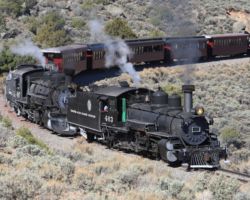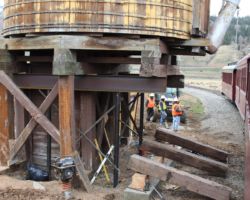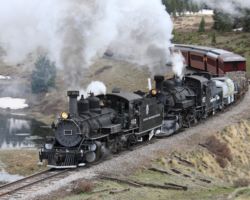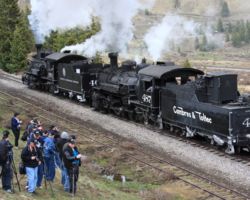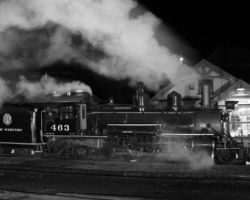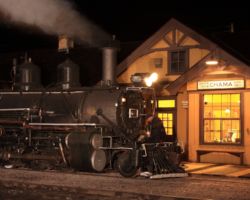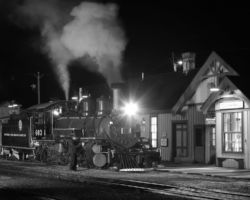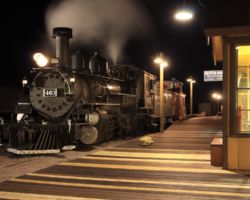Originally published on DRGW.Net on May 24, 2013
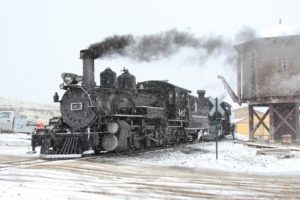
The oldest class of D&RGW narrow gauge 2-8-2s, the K-27s, turn 110 years old this year. Fifteen of these inside-frame 2-8-2s were originally built by Baldwin in 1903 to help modernize motive power on the then still-extensive narrow gauge system. They were the biggest D&RG narrow gauge motive power to that point, earning the original designation “Class 125” to reflect their 63 ton weight. Their size and large counterweights tested the sometimes questionable trackwork of the time, causing them to “waddle” down the track (and more than once, off the track), earning them the nickname “Mudhens”.
The class, while unquestionably a success for the Rio Grande, underwent a good number of improvements over its original design specifications. The engines were originally built as saturated steam Vauclain compound expansion engines, but the complexities of the system proved to outweigh the advantages. They were converted back to simple expansion engines with slide valves and Stephenson linkages starting in 1906. Also, the original tenders were slope-back designs and far too small for road service. That was quickly remedied with conventional square tenders. Eventually eleven of the class were upgraded again to piston valves and Walschaerts valve gear, and ten of those were then given superheater tubes to increase efficiency and power. Even that wasn’t enough to make them competitive with the larger engines now on the line – the K-28s, K-36s, and K-37s, and so the Grande began ridding themselves of the engines. Starting in 1939, the scrapped the four that hadn’t received upgrades. The ones that were left were relegated primarily to yard service by the shrinking traffic and . Of the remaining eleven, two went to the RGS to modernize their power in the 1940s, and two more went to Mexico’s NdeM, where they were converted to standard gauge engines. By the close of the 1950s, only two survived – 463 and 464.
463 escaped Colorado and the scrapper’s torch when it was sold to Gene Autry in 1955. Gene never used the engine for much, and eventually donated it back to the town of Antonito, Colorado, in the early 1970s. The 463 was then eventually leased to the Cumbres & Toltec Scenic Railroad Commission, and it was rebuilt and placed in service for the 1994 season. With the advent of the new FRA Part 230 boiler regulations that went into effect in January 2002, 463 was sidelined with a broken side-rod and for need of a boiler overhaul at the close of the 2002 season. The C&TS, in dire straits at the time, prioritized its very limited funding towards the much more useful K-36 fleet, and mothballed the 463 until monies became available for her rebuild.
(The other surviving K-27 – 464 – was officially retired in 1962, becoming a parts source and static fixture in the Durango yard. In 1973, when it also left for California – this time for the Knotts Berry Farm railroad that had also picked up several choice pieces of RGS equipment. Knotts found the locomotive unsuitable due to its size and large, low-hanging counterweights, and eventually sold it in 1981 after only intermittant use. The locomotive headed east to the Genesee County Parks and Recreation’s Huckleberry Railroad in Flint, MI, where it operates regularly to this day.)
Through the efforts of many donors, the Friends of the Cumbres & Toltec, and thousands of hours of work by volunteers, contractors, and the C&TS shop crews, 463 returned to operation in the spring of 2013. Her first revenue trip was on May 20, 2013, on the point of the annual deadhead move of cars from Antonito over to Chama for the 2013 season. The Friends sold tickets on this normally-empty move to celebrate the return of 463, and had a huge taking – roughly 250 sold. Needless to say, I had mine the first day they were offered for sale.
The trip wasn’t without incident. 463 was placed at the head, but K-36 487 was placed right behind it. There was some concern that the little K-27 might run into trouble, either mechanical or with the tonnage, or that it might run low on water because of its smaller tender. To help alleviate the second concern, a water tanker and pump were placed right behind the power. The plan – per Roger Hogan – was to pull off the 487 at either Big Horn, Sublette, or worst cast Osier if it wasn’t needed. We departed a few minutes late (around 0845h), but things went generally well. A few miles out of Antonito, when we noticed a squealing from the first truck on the tourist class car (C&TS 511, “Chama”). Nobody on the crew seemed all that interested, though, and we proceeded on with our first run-by at Gravity Hill, the first big climb about 2.5 miles east of Lava Tank.
Somewhere just past Lava, the crew decided to stop and check the squealing. As it turns out, our car were developing a bit of a hot box in one of the journals beneath my seat. These cars still have traditional solid bearings, where the machined axle end sits in a curved brass bearing lined with babbitt metal. A thin layer of oil is wicked up into this interface through cotton batting (called “waste”) to provide a lubricating film. It normally all works rather reliably, and was in use by railroads for over 100 years until roller bearings became required in 1974. In our case, the interface between the brass and the axle wasn’t getting proper oiling, causing friction and heat, which only further damaged the bearing surface. The on-board crew inspected it, but lacking additional cotton waste to wick the oil up (or for that matter, any extra oil), the decision was made to proceed a few more miles into Big Horn to get a proper maintenance crew on it. While underway, near the upper Whiplash Curve, somebody spotted smoke coming from another hot journal – this time on the back of the parlor car. With two hot bearings, we limped into Big Horn so the shop guys culd work their magic.
Marvin Casias and his team were waiting for us at Big Horn with a truck full of tools and parts. Without missing a beat, they started jacking up the car and pulled out the damaged brass. By the time it came out, the babbitt metal on the inside of the brass was scoured away on part of the surface. Since it was all on the truck under my seat, I got the privilege of watching the whole experience. Once they were finished with coach 511, they headed back to the parlor car to repeat the process. While all of this was going on, 463 needed to be watered (as it had been doing most of the work all morning). However, the hose was too short to reach from the tank car to the tender around the 487. So the 463 was cut off and sent up the wye leg, where the hose could reach across the gap. All said and done, it took around 85 minutes to complete servicing and we were underway again.
While we’d been sitting there, the clouds had begun to roll in. It was already a fairly cool morning, but with the sun gone it dropped to just plain cold. Another water stop was made at Sublette, and from there it was a highball into Osier given our lateness. The two run-bys planned along the way (one for the Friends video team, one for all of us) were bypassed in the name of lunch. Somewhere around Mud Tunnel, our favorite bearing started screaming again. By the time we reached our lunch stop (in a late spring snow squall, I might add), we’d fried another brass. This time, though, it was hot enough they had to cool it with water for some time before it would contract enough to come out. Lunch was some of Stephen’s delicious roast chicken with potatoes, beans, cole slaw, and of course the famous deserts, but I’ll admit to being late and having to wolf it down. Somehow photographing a rare westbound double-header in the snow seemed more pressing than eating, at least for a few minutes.
Leaving Osier, the snow quickly let up, completely dissipating by Cascade Trestle. Of course, like Lobato, you can’t operate two large 2-8-2s across it at the same time, so 463 had to be cut off to run ahead. Still losing time, the run-bys at Cascade (again video guys only) and Los Pinos got canned. We did, however, manage to fit in the one at Tanglefoot Curve, just east of Cumbres Pass. With the run-by complete, the 487 cut off and running ahead light and the retainers set up, it was a nice relaxing ride down the hill. That said, it was some of the most awesome light of the day. I wish I’d bummed a ride off some of the chasers I knew, as so that I could have gotten a few shots from the highway.
While there were only two run-bys on the trip, I’ve managed to pull enough decent stuff together (I hope) to make a decent trip report. Enjoy!
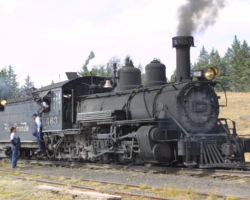
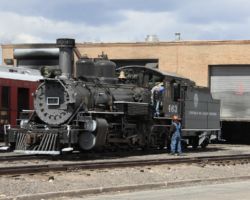
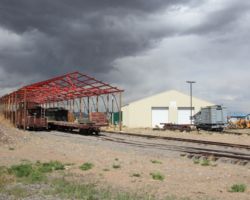
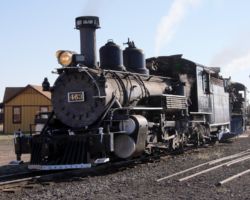
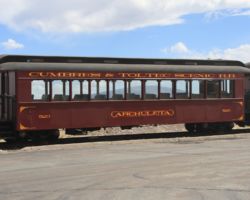
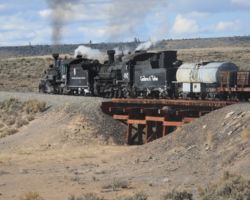
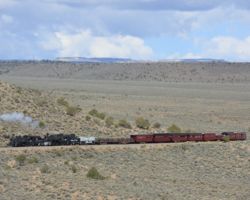
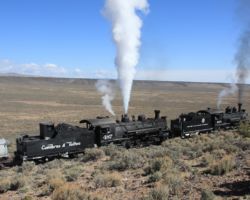
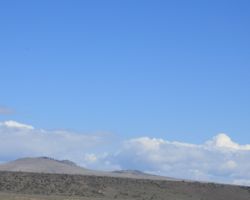
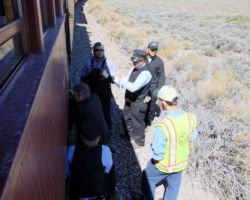
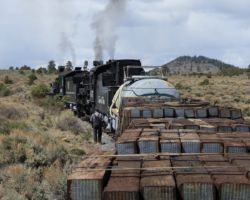
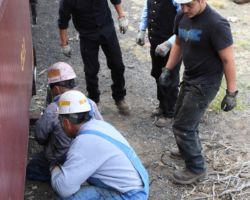
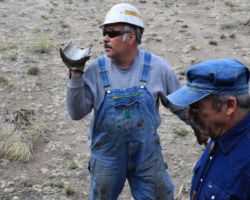
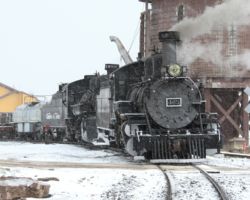
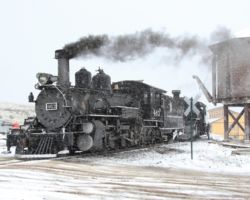
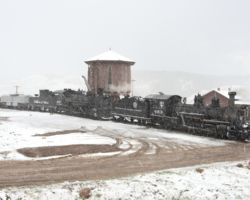
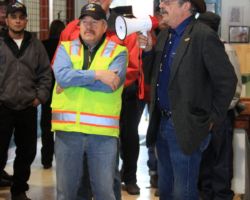
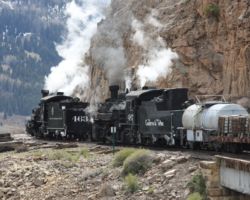
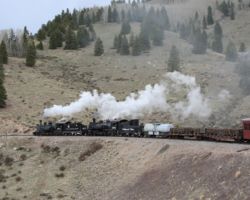
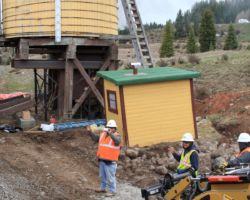
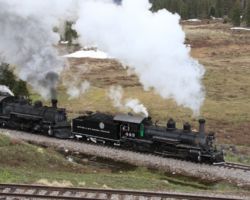
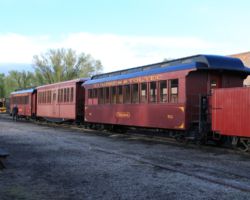
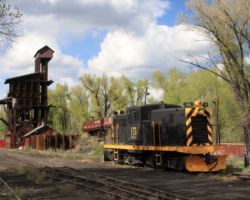
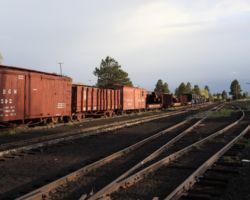
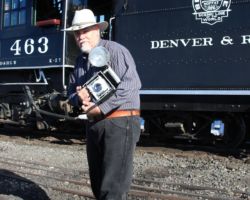
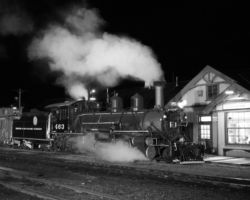
All photographs in this trip report were taken with a Canon EOS 1D Mark III or Canon EOS 40D combined with either a Canon 24-105mm f/4L IS/USM, Canon 17-40mm f/4L USM, or a Canon 28-300mm f/3.5-5.6L IS/USM.
